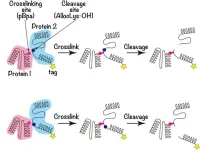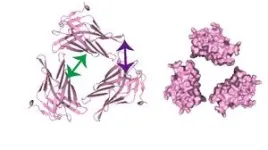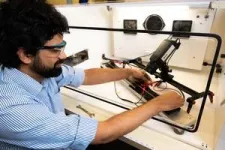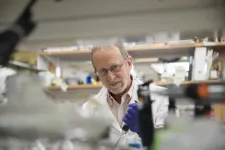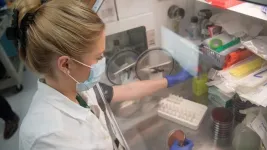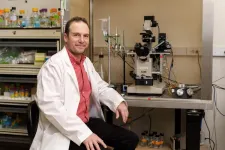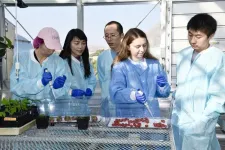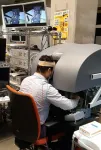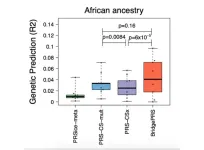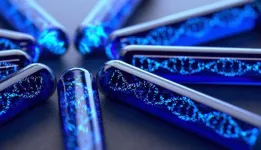Protein secrets unveiled: Newl molecular insight of protein–protein interactions
2023-12-20
(Press-News.org)
Researchers from Tokyo Medical and Dental University (TMDU) have developed a new technique allowing the binding interfaces on two interacting proteins to be characterized, and validated it by describing the homophilic interaction between LAMP2A molecules
Tokyo, Japan – Proteins are building blocks of our bodies, but they do not work solo. They form partners to facilitate in different biological processes that keep us going. However, analyzing how proteins interact at a molecular level can be challenging. Now, a research team from Japan reveals the secrets behind these “protein partnerships”.
In a study published recently in Protein Science, researchers from Tokyo Medical and Dental University (TMDU) have developed a novel method by combining two techniques in a way that allows identification of the site of interaction on two protein molecules.
A protein consists of a chain of molecules called amino acids, that then forms a three-dimensional structure. An amino acid known as pBpa, which would not naturally occur anywhere else in the protein, can be introduced into a protein of interest using genetic code expansion (GCE). Irradiation with light will then cause two interacting proteins to cross-link and stick together. However, while the site of the pBpa insertion is known, narrowing down the interacting region on the second protein is very difficult.
To solve this, the team introduced a cleavage site, “AllocLys-OH”, at a known location on the second protein using GCE. “Cleaving the crosslinked proteins at this site then provides information as to which side of the AllocLys-OH site the binding interface is located at,” explains first author Kazue Terasawa. “One end of each protein is tagged in a detectable way. If the cleavage experiment separates these tags, then the cleavage site is closer to the tagged end of the protein than the crosslinked interaction site.” By performing a series of these experiments with the AllocLys-OH cleavage site in different positions, the location of the binding interface on the second protein can be narrowed down.
They went on to validate this technique by examining the binding site of a protein called LAMP2A. This is a major component of the membrane around a cellular structure called a lysosome and is a receptor for a process known as chaperone-mediated autophagy, key for breaking down proteins within a cell as part of normal cellular function. Individual molecules of LAMP2A are known to bind together in a homophilic interaction, but the details of this interaction were not fully known.
“After a series of crosslinking and cleavage experiments, we were able to clarify the geometry of the LAMP2A homophilic interaction. Based on the protein’s known three-dimensional structure, the locations of the interaction sites we discovered indicate that LAMP2A must form a trimeric, or higher oligomeric, structure,” explains senior author Miki Hara-Yokoyama.
This novel method is a major breakthrough for researchers studying protein–protein interactions. It allows protein-binding interfaces to be characterized, revealing complex protein geometries. It is also applicable to all mammalian cells, and therefore it may be useful for therapeutic applications.
###
The article, “Site-specific photo-crosslinking/cleavage for protein–protein interface identification reveals oligomeric assembly of lysosomal-associated membrane protein type 2A in mammalian cells”, was published in Protein Science at DOI: 10.1002/pro.4823.
END
ELSE PRESS RELEASES FROM THIS DATE:
2023-12-20
University of Virginia Alzheimer’s researchers have discovered how harmful tau proteins damage the essential operating instructions for our brain cells, a finding which could lead to new treatments.
The toxic protein, the researchers found, warps the shape of the nuclei of nerve cells, or neurons. This alters the function of genes contained inside and reprograms the cells to make more tau.
While the protein has long been a prime suspect in Alzheimer’s and other neurodegenerative “tauopathies,” the new research from UVA’s ...
2023-12-20
Fraunhofer USA, a leading nonprofit research organization dedicated to applied research and development services, is proud to announce the release of its Annual Report, Focus 2023. The report underscores Fraunhofer USA's commitment to fostering transatlantic collaboration, strengthening university-government partnerships, and driving impactful technology transfer.
Transatlantic Collaboration: A Pillar of Innovation
In the pursuit of global innovation, Fraunhofer USA continues to play a pivotal role in fostering transatlantic collaboration. The annual report highlights the organization's successful partnerships with Fraunhofer-Gesellschaft research institutes, resulting in groundbreaking ...
2023-12-20
PLYMOUTH MEETING, PA [December 20, 2023] — The National Comprehensive Cancer Network® (NCCN®)—an alliance of leading academic cancer centers in the United States—is celebrating six years of working alongside the African Cancer Coalition (ACC), the American Cancer Society (ACS), and the Clinton Health Access Initiative (CHAI), as part of Allied Against Cancer. The collaboration was formed to support and empower the Sub-Saharan African oncology community to advance health system capacity, ...
2023-12-20
A new study from Lawson Health Research Institute and Western University published in the journal Microbiome has found changes in the microbiome in multiple locations in the body are linked to the formation of kidney stones.
The human microbiome comprises trillions of microorganisms, including healthy bacteria. In recent years, research has begun to uncover its role in health and numerous diseases.
The research team examined the gut, urinary and salivary microbiomes in 83 patients who had kidney stones ...
2023-12-20
Brine shrimp of the genus Artemia are small crustaceans that can thrive in environments where sodium concentrations are as high as 25% (more than eight times typical ocean sea water). Also known by the household pet trademark ‘sea monkeys,’ these animals are abundant in inland salt lakes where brine-fly larvae are the only other animals known to exist.
The mechanisms which permit brine shrimp to tolerate some of the harshest environments are only partially understood. Previously known adaptive features include a tight protective layer (integument) to avoid water loss and the increased extrusion of sodium (Na+) and chloride (Cl-) ions ...
2023-12-20
Quality of life for people with dementia living in residential and nursing home care substantially improved after staff took part in a digital training programme that was specially adapted to Covid-19 restrictions. The training also led to a significant drop in the prescription of potentially harmful sedative medications to residents.
The iWHELD programme supported care home staff in delivering personalised care and encouraging meaningful social interactions. Through a digital platform featuring live coaching sessions led by trained coaches, the programme supported ...
2023-12-20
UC Riverside scientists have discovered a stealth molecular weapon that plants use to attack the cells of invading gray mold.
If you’ve ever seen a fuzzy piece of fruit in your fridge, you’ve seen gray mold. It is an aggressive fungus that infects more than 1,400 different plant species: almost all fruits, vegetables, and many flowers. It is the second most damaging fungus for food crops in the world, causing billions in annual crop losses.
A new paper in the journal Cell Host & Microbe describes how plants send tiny, innocuous-seeming lipid “bubbles” filled with RNA across enemy lines, into the cells of the aggressive mold. Once ...
2023-12-20
People who received gentle electric currents on the back of their heads learned to maneuver a robotic surgery tool in virtual reality and then in a real setting much more easily than people who didn’t receive those nudges, a new study shows.
The findings offer the first glimpse of how stimulating a specific part of the brain called the cerebellum could help health care professionals take what they learn in virtual reality to real operating rooms, a much-needed transition in a field that increasingly relies on digital simulation training, said author and Johns Hopkins University roboticist Jeremy ...
2023-12-20
A team of scientists from Icahn School of Medicine at Mount Sinai has developed a groundbreaking statistical technique, “BridgePRS,” to enhance disease prediction in people of non-European ancestry, particularly those of African descent. This development represents a substantial step towards reducing health care inequities and a future of more personalized and precise medical interventions based on genetic information. Details of their work were published in Nature Genetics on Wednesday, December 20.
Current polygenic risk scores (PRS), essential tools for predicting disease risk encoded in our ...
2023-12-20
A groundbreaking new technique invented by researchers at the USC Dornsife College of Letters, Arts and Science may revolutionize the field of synthetic biology. Known as CReATiNG (Cloning Reprogramming and Assembling Tiled Natural Genomic DNA), the method offers a simpler and more cost-effective approach to constructing synthetic chromosomes. It could significantly advance genetic engineering and enable a wide range of advances in medicine, biotechnology, biofuel production and even space exploration.
CReATiNG works by cloning and reassembling natural DNA segments from yeast, allowing scientists to create synthetic chromosomes that can replace their native counterparts in cells. ...
LAST 30 PRESS RELEASES:
[Press-News.org] Protein secrets unveiled: Newl molecular insight of protein–protein interactions
